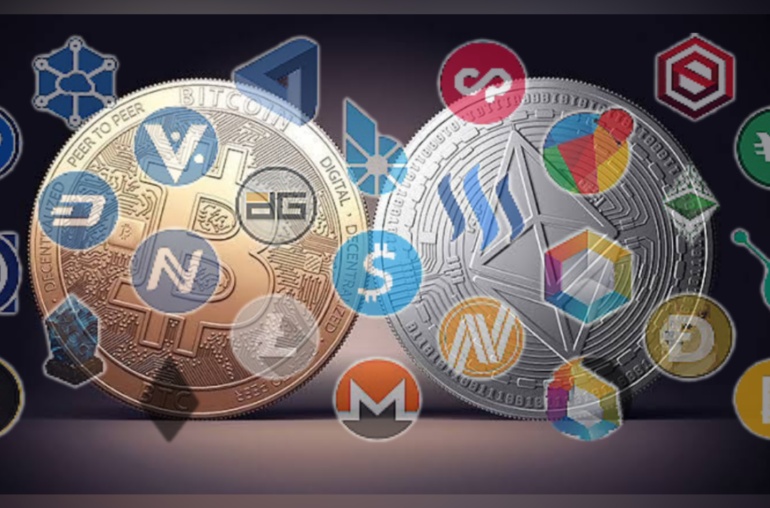You’ve probably heard of bitcoin, Ethereum, BNB, Doge, USDT, or other cryptocurrencies. There are currently thousands of cryptocurrencies out there. And they are of different types. Various types of cryptocurrencies serve various purposes, including payment, investment, network, and stabilization purposes in the crypto market or ecosystem. In this piece, you will get to understand better what cryptocurrencies are and the major types of cryptocurrencies with examples of each.
Meaning of Cryptocurrency
“Cryptocurrency” is a combination of the words “crypto” and “currency”. While “crypto” is derived from the Greek word “kryptos” which means hidden, “currency” is derived from the Latin word “currens” which means a “state or fact of flowing from person to person”. Therefore, a cryptocurrency essentially serves as an encrypted or secured medium of exchange. And this is without the need for a central bank or third party.
Many cryptocurrencies are without a central authority. They run on blockchain technology—a trustless technology that needs no intermediary to store, trade, or transfer anything of value between parties. Without a central authority, middleman, or intermediary, many cryptocurrencies are decentralized networks. This is why most cryptocurrencies, such as bitcoin and ethereum for example, run on public and permissionless blockchains.
Cryptocurrency, also called crypto asset or virtual currency, involves cryptographic means of achieving some level of privacy and security. This could be by making the user pseudonymous or anonymous, depending on the design of the cryptocurrency. Cryptography involves techniques of securing communications whereby messages between a sender and the intended receiver are encrypted or hidden. This privacy design of cryptocurrencies is a major reason why governments—particularly law enforcements and regulators—generally distrust cryptocurrencies. According to most law enforcements and regulators, cryptocurrencies are often used to commit fraud, money laundering, and terrorism financing. This viewpoint continues to affect the approach to cryptocurrency regulation globally.
However the current regulatory issues surrounding cryptocurrencies or crypto assets, cryptocurrencies or crypto assets have greatly evolved since the invention of bitcoin by Satoshi Nakamoto in 2009. Cryptocurrencies or crypto assets are increasingly attracting both retail and institutional adopters. From PayPal to Tesla, JPMorgan to Mastercard, cryptocurrency adoption is spreading, and fast. In an unprecedented development in June 2021, bitcoin was adopted as a legal tender in El Salvador.
First, a cryptocurrency is typically a decentralized digital currency with no central authority issuing unlike fiat currencies such as the Dollar, Pounds, Yen, or the Naira which are issued by central or reserve banks. Second, cryptocurrencies are secured using cryptography, a means of securing communication by hiding plaintext with cyphertext. It is these two characteristics that mainly distinguish cryptocurrencies from electronic currencies as well as Central Bank Digital Currencies (CBDCs). The first well-known and the most adopted cryptocurrency is bitcoin. Bitcoin is also the first cryptocurrency that has been made a legal tender in El Salvador in June 2021.
Related: What is Blockchain Technology? Meaning, Types, and Use Cases

Types of cryptocurrencies and their functions
Cryptocurrencies, crypto assets, or also called virtual currencies are of various types and capable of serving various functions. A cryptocurrency or crypto asset can serve an investment function, a payment function, or a utility function. A better understanding of cryptocurrencies requires that you understand these different cryptocurrencies and what functions they serve in the crypto market. Let’s look at the types of cryptocurrencies or crypto assets under 4 broad categories.
- Payments A cryptocurrency or crypto asset may be used to enable cheaper, easier, and faster payments. Where a cryptocurrency or crypto asset serves a payment function, it is digital money.As digital money, a cryptocurrency or crypto asset serves as a medium of exchange, a unit of account, and/or a store of value. This is where “cryptocurrency” derives its suffix, “currency”.But cryptocurrencies do not have legal tender status since they are not issued by a central or reserve bank. Payment cryptocurrencies include Litecoin (LTC), bitcoin (BTC), Ripple (XRP), and Cardano (ADA).
- Investments A cryptocurrency or crypto asset may be acquired as assets for investments. As an asset, a cryptocurrency or crypto asset serves as a digital representation of value that can be digitally traded or transferred just as stocks. Particularly at this early stage in the emergence of cryptocurrencies or crypto assets—in the absence of intrinsic value—price volatility is prevalent in the crypto market. Consequently, investors often speculate on the prices of cryptocurrencies or crypto assets in their investment portfolio. Generally, both institutional and retail investors engage in these speculative investments in order to make profit. Being highly speculative, investing in cryptocurrencies or crypto assets can result in the loss of your entire investment.While you could invest in a cryptocurrency or crypto asset such as bitcoin, Ethereum, and litecoin for example, these cryptocurrencies should be distinguished from what is called security tokens. Unlike bitcoin or Ethereum for example which have their own blockchains, security tokens do not. Security tokens run on existing blockchains. They are typically issued and marketed by a company or organization, not a decentralized network. Essentially a digital form of traditional securities such as bonds, ETFs, futures, options, and stocks, security tokens entitle their holders to profit from the performance of the token. This works like share ownership and dividends. Examples of cryptocurrencies or crypto assets that are often traded in order to profit from their appreciation in price value include bitcoin (BTC), Ethereum (ETH), and many other cryptocurrencies. On the other hand, a well-known example of a security token is Blockchain Capital (BCap).
- Utility A cryptocurrency or crypto asset may provide user access to a future product or service. This is called utility tokens. And this is why cryptocurrencies or crypto assets that fall under this utility category may also be called access, gateway, or user tokens. They are also sometimes called app coins. This is because such cryptocurrency has been designed to work as the native coin within the ecosystem of the project that created it.Basically, a utility token works like a coupon that the owner can redeem in the future for special access to a product or service or to enjoy discount offers. But some utility tokens, similar to payment tokens, may serve as a store of value and be used to facilitate transactions inside and outside the given ecosystem. Examples of utility tokens include Binance Coin (BNB), Filecoin (FC), Basic Attention Token (BAT), Polkadot (DOT), Solana (SOL), and thousands of others.
- Stablecoin There are cryptocurrencies or crypto assets that are backed by fiat, other cryptocurrencies, or other assets or reserves in order to protect against the high price volatility that is commonly associated with cryptocurrencies. These cryptocurrencies or crypto assets are called stablecoins.Apart from helping to ensure price stability, stablecoins also make buying and selling of cryptocurrencies possible without the need to resort to the dollar, euro, pound, yen, or other fiat currencies. This is because stablecoins basically bridge the crypto world and the fiat world. Stablecoins include Tether (USDT), USD Coin (USDC), Binance USD (BUSD), Dai (DAI), TerraUSD (UST), TrueUSD (TUSD), Paxos Standard (PAX), Reserve Rights (RSR), HUSD (HUSD), NeutrinoUSD (USDN), Federal Protocol (FEI), Gemini Dollar (GUSD), and over 50 others currently.
Read also: What are the top 5 centralized crypto exchanges you should know?
Rounding off
Whether as digital money, investment, utility, or stablecoin, the adoption of cryptocurrencies or crypto assets by both institutional and retail investors is growing exponentially.
By getting to understand better what cryptocurrencies or crypto assets are, you will be able to make informed decisions before taking any bite in the ever-volatile crypto market.





8 Comments